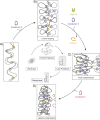Shaping mitotic chromosomes: From classical concepts to molecular mechanisms
- PMID: 25988527
- PMCID: PMC4683672
- DOI: 10.1002/bies.201500020
Shaping mitotic chromosomes: From classical concepts to molecular mechanisms
Abstract
How eukaryotic genomes are packaged into compact cylindrical chromosomes in preparation for cell divisions has remained one of the major unsolved questions of cell biology. Novel approaches to study the topology of DNA helices inside the nuclei of intact cells, paired with computational modeling and precise biomechanical measurements of isolated chromosomes, have advanced our understanding of mitotic chromosome architecture. In this Review Essay, we discuss - in light of these recent insights - the role of chromatin architecture and the functions and possible mechanisms of SMC protein complexes and other molecular machines in the formation of mitotic chromosomes. Based on the information available, we propose a stepwise model of mitotic chromosome condensation that envisions the sequential generation of intra-chromosomal linkages by condensin complexes in the context of cohesin-mediated inter-chromosomal linkages, assisted by topoisomerase II. The described scenario results in rod-shaped metaphase chromosomes ready for their segregation to the cell poles.
Keywords: SMC complex; chromosome condensation; chromosome segregation; cohesin; condensin; mitosis; topoisomerase II.
© 2015 The Authors. Bioessays published by WILEY Periodicals, Inc.
Figures


References
-
- Flemming W. 1882. Zellsubstanz, Kern und Zelltheilung. VDM, Müller.
-
- Belmont AS. Mitotic chromosome structure and condensation. Curr Opin Cell Biol. 2006;18:632–8. - PubMed
-
- Luger K, Mäder AW, Richmond RK, Sargent DF, et al. Crystal structure of the nucleosome core particle at 2.8 A resolution. Nature. 1997;389:251–60. - PubMed
-
- Davey CA, Sargent DF, Luger K, Maeder AW, et al. Solvent mediated interactions in the structure of the nucleosome core particle at 1.9 a resolution. J Mol Biol. 2002;319:1097–113. - PubMed
-
- Olins AL, Olins DE. Spheroid chromatin units (v bodies) Science. 1974;183:330–2. - PubMed
Publication types
MeSH terms
Substances
LinkOut - more resources
Full Text Sources
Other Literature Sources

